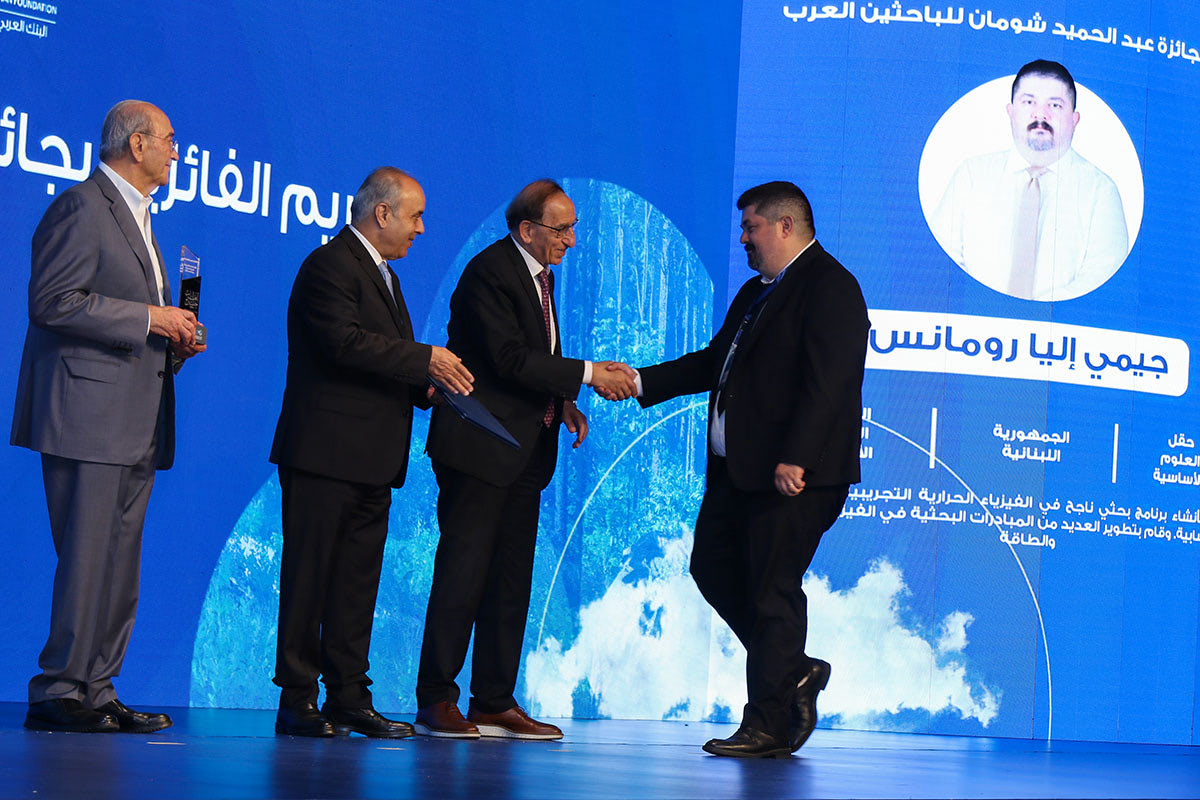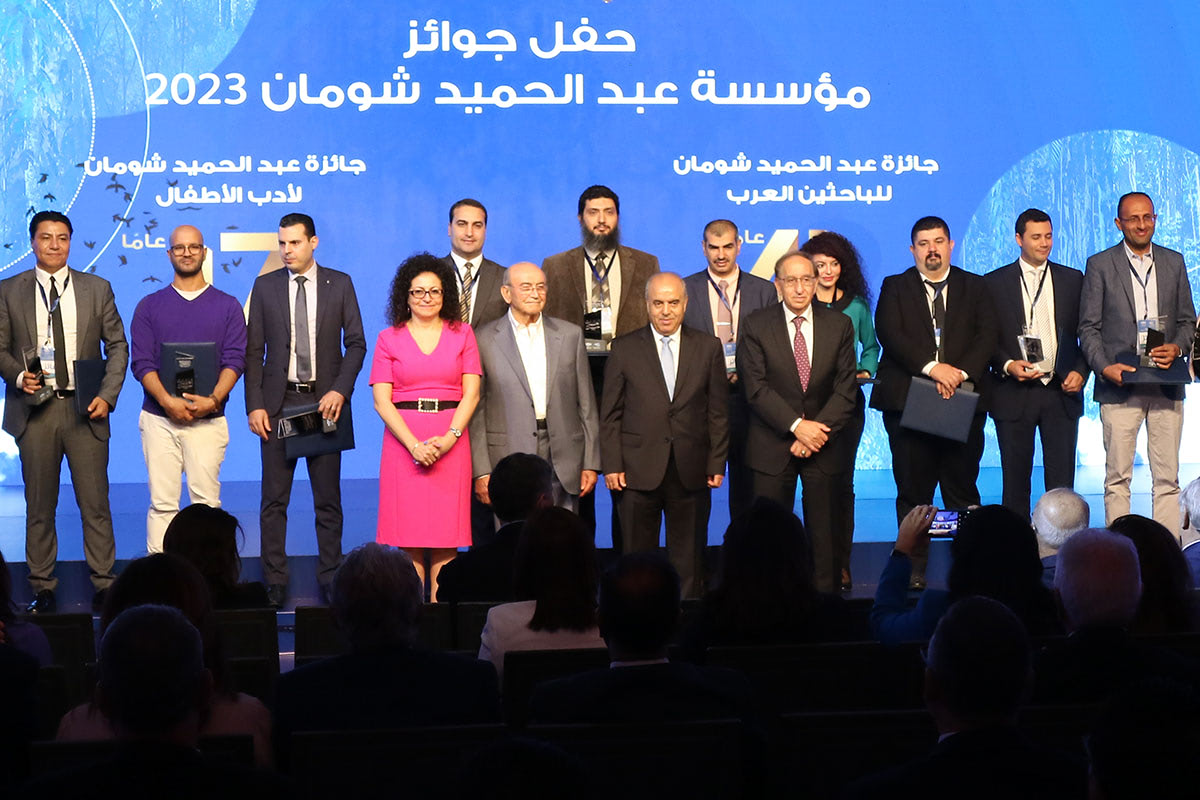Dr. Jimmy Romanos Receives the Prestigious Shoman Award
The LAU Associate Professor of Physics has won the 2023 Abdul Hameed Shoman Foundation Award for Arab Researchers for his contributions to applied knowledge in thermal physics.
Associate Professor of Physics Jimmy Romanos has received the prestigious 2023 Abdul Hameed Shoman Foundation Award for Arab Researchers in recognition of his pioneering research in thermal physics. The award recognizes research by Arab scholars that advance scientific and applied knowledge and help resolve critical problems locally, regionally and globally.
This marks LAU’s third win for a faculty member, previously earned by Professor of Biology Mirvat El-Sibai and Associate Professor of Journalism and Media Studies Jad Melki for their research, respectively, on cancer metastasis and the impact of social media in the Arab world.
Dr. Romanos is the first Lebanese scientist to receive the award in physics.
His research on gas adsorption and energy-related technologies involves developing new materials and processes for sustainable energy storage and carbon capture to mitigate greenhouse gas emissions and enable renewable energy sources. It has been applied in advancing carbon capture and new storage technologies and revolutionized the efficiency and capacity of energy storage systems.
Notably, during his time in the oil and gas industry at OsComp Systems Inc. in Houston, Texas, before joining LAU as an assistant professor of physics in 2014, he led a team of researchers in developing sorbent materials for the upstream and downstream sectors of the natural gas industry.
Dr. Romanos’ research has been published in top-quartile and prestigious journals, presented at various local and international conferences and resulted in three patents. With academic degrees in physics and mechanical and aerospace engineering from the University of Missouri, US, he has worked on various projects for the California Energy Commission and other energy-related entities.
With this expertise, he established a flourishing and successful research program in computational, theoretical and experimental thermal physics at LAU.
In this interview, Dr. Romanos expounds on his research and his experience at LAU.
Can you tell us more about the research or contributions that led to your selection for this prestigious award?
I use experimental and computational methods to study the complex thermodynamics of gas adsorption at the atomic scale, focusing on the interfaces of solid and gas within pores that are only a few angstroms – a hundred-millionth of a centimeter – in diameter.
Understanding how gases adsorb to solid surfaces in nanoporous materials – porous materials with pore diameters less than 100 nanometers – can help us develop sorbent materials for natural gas and hydrogen storage, which can radically transform the efficiency and capacity of energy storage systems, as well as capture and store greenhouse gases.
My research has been used in applications to develop carbon capture and new energy storage technologies, which are essential for mitigating greenhouse gas emissions. In addition, the knowledge disseminated by my research into the intricacies of methane hydrates and the factors that affect their stability is fundamental to assessing the potential impact of methane hydrates on climate change.
What implications does this stability of methane hydrates have for climate change and our understanding of it?
Methane hydrates, naturally occurring compounds abundant on the ocean floor and in permafrost regions, consist of methane molecules trapped within water molecule cages. They contain more carbon than all known fossil fuels combined. These hydrates remain stable under specific temperature and pressure conditions, but as the ocean warms due to climate change, their stability is compromised, potentially releasing methane into the atmosphere, a potent greenhouse gas that could further accelerate climate change.
Various factors, including temperature, pressure, salinity and the presence of compounds influence methane hydrate stability, with climate change being the primary factor. Natural disasters and human activities can also play a role. The consequences of methane hydrate dissociation for climate change are profound, as the release of a substantial amount of methane, a far more potent greenhouse gas than carbon dioxide, could lead to rapid warming.
What are some of the main challenges your research on carbon capture aims to address, and how can it contribute to mitigating greenhouse gas emissions effectively?
The current atmospheric CO2 concentration of 418 ppm is unprecedented in human history and a significant cause for concern. Researchers are exploring diverse avenues for carbon capture, including biological, physicochemical and geological methods. I recently started investigating selective adsorption for carbon dioxide capture from the atmosphere. Adsorption, a highly efficient method for separating various gases, holds tremendous promise for carbon dioxide capture.
My work centers on developing specialized adsorbents – or materials designed to attract and retain molecules on their surface – that exhibit a high degree of selectivity for carbon dioxide while remaining cost-effective. This is vital for diminishing atmospheric CO2 levels and ultimately decelerating the adverse effects of climate change.
Can you give an example or scenario where your work might lead to a breakthrough in enhancing energy storage capacity or efficiency?
Hydrogen is a promising energy storage technology, especially for the long-term vision of a clean energy economy. It can be produced from renewable energy sources such as wind and solar power, and only emits water and heat as byproducts, which makes it an attractive option for storing excess energy generated from renewables and using it later when needed.
However, there are still some challenges that need to be addressed before hydrogen can be widely adopted as an energy storage solution, namely improving the efficiency and cost of hydrogen production, storage and fuel cell technology. My research focuses on developing solid-state hydrogen storage by physisorption (the physical bonding of gas molecules), a promising technology that could help overcome some of the challenges associated with hydrogen storage.
How has the support you received at LAU contributed to this accomplishment?
LAU gave me the opportunity to return home a decade ago and pursue my passion for teaching and research. Leaving my job in the oil and gas industry in Houston and returning home was a difficult decision, but one that I am confident was the right choice. I am grateful for the intramural funding that LAU has provided to support my research, which has paved the way for extramural funding.
I am also deeply grateful to my mentors, colleagues, postdocs and students for their guidance, support, and hard work. My mentors have taught me so much about research and academia, and my colleagues have been a constant source of support and inspiration. Collaborating with my postdocs has been a pleasure. They have worked tirelessly to help me with my research and have made significant contributions.
To browse scholarly output by the LAU community, visit our open-access digital archive, the Lebanese American University Repository (LAUR).

